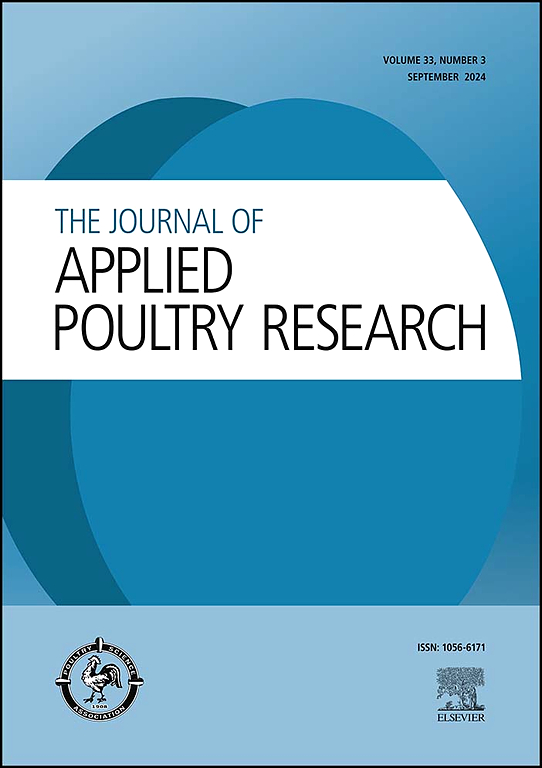Relative bioavailability of 25-hydroxyvitamin D3 compared to vitamin D3 for laying performance and egg quality in laying hens from 41 to 48 weeks of age
IF 2
3区 农林科学
Q2 AGRICULTURE, DAIRY & ANIMAL SCIENCE
引用次数: 0
Abstract
Currently, the primary supplemental forms of vitamin D (VD) for laying hens’ diets are traditional Vitamin D3 (VD3) and its intermediate metabolite, 25-hydroxyvitamin D3 (25-OHD). However, the application effect of 25-OHD in laying hens has always been subject to some controversy. The objective of this study was to evaluate the relative bioavailability of 25-OHD compared to VD3 in terms of laying performance and egg quality for laying hens from 41 to 48 wk of age. A total of 936 thirty-six-wk-old Roman pink-shell laying hens were fed a basic diet without any additional VD for 5 wk (from wk 36 to 40). Subsequently, A total of 768 hens were selected and randomly assigned to 16 dietary treatments for 8 wk (from wk 41 to 58), including a 0 IU/kg VD control group and groups supplemented with 75, 150, 225, 300, 1600 IU/kg of VD3, 25-OHD-1 (provided by DSM Ltd.), or 25-OHD-2 (provided by Shandong Haineng Bioengineering Co., Ltd.). The results indicated that increasing VD levels significantly improved the hen day laying rate (HDLR), hen-housed laying rate (HHLR), qualified egg rate, egg weight (EW) and ADFI during wk 45–48 (P < 0.05), and significantly reduced FCR during wk 45–48 (P < 0.05). Compared with VD3 group, the HDLR and HHLR during wk 45–48 in 25-OHD-1 and 25-OHD-2 group were increased significantly (P < 0.05), and the FCR during wk 45–48 was decreased significantly (P < 0.05). Otherwise, compared with VD 75 IU/kg, the increase of VD level significantly increased the eggshell strength, eggshell thickness and relative weight of eggshell at 44 and 48 wk of age (P < 0.05). The yolk relative weight at 48 wk of age in the VD 75 IU/kg group was significantly higher than that in other groups (P < 0.05). The eggshell strength and relative weight of eggshell at 44 wk of age in the 25-OHD-1 and 25-OHD-2 group were higher (P < 0.05) than those in the VD3 group. Compared with control group, dietary supplementation with VD improved tibia strength and reduced tibia P content (P < 0.05). The tibia strength in the 25-OHD-2 group was the best among three VD source groups (P < 0.05). Taking VD3 as 100%, 25-OHD-1 and 25-OHD-2 had relative biological values of 137.6–182.6% and 135.9–195.9% for laying performance, and 108–254.4% and 93–323.5% for eggshell quality, respectively. Overall, the 25-OHD-1 and 25-OHD-2 was approximately 1.6–1.9 times as effective as VD3 for laying performance and egg quality. The bioavailability of 25-OHD-1 and 25-OHD-2 was no different.
25-羟基维生素D3与维生素D3相对生物利用度对41 ~ 48周龄蛋鸡产蛋性能和蛋品质的影响
目前,蛋鸡饲粮中维生素D (VD)的主要补充形式是传统的维生素D3 (VD3)及其中间代谢产物25-羟基维生素D3 (25-OHD)。然而,25-OHD在蛋鸡中的应用效果一直存在争议。本研究的目的是评估25-OHD与VD3在41 ~ 48周龄蛋鸡产蛋性能和蛋品质方面的相对生物利用度。试验选取936只36周龄罗马粉壳蛋鸡饲喂基础饲粮,不添加任何额外的VD,饲喂5周(第36 ~ 40周)。选取768只蛋鸡,随机分为16个饲粮处理,分别为0 IU/kg VD对照组和添加75、150、225、300、1600 IU/kg VD3、25-OHD-1(帝司有限公司提供)和25-OHD-2(山东海能生物工程有限公司提供)组,试验期8周。结果表明,增加VD水平可显著提高45-48周母鸡日产蛋率、母鸡舍产蛋率、合格蛋率、蛋重和ADFI (P <;45-48周FCR显著降低(P <;0.05)。与VD3组比较,25-OHD-1和25-OHD-2组患者45-48周HDLR和hlr显著升高(P <;45 ~ 48周FCR显著降低(P <;0.05)。另外,与VD 75 IU/kg相比,VD水平的提高显著提高了44和48周龄蛋壳强度、蛋壳厚度和蛋壳相对重量(P <;0.05)。75 IU/kg VD组48周龄蛋黄相对重显著高于其他各组(P <;0.05)。25-OHD-1和25-OHD-2组44周龄蛋壳强度和蛋壳相对重量较高(P <;0.05),高于VD3组。与对照组相比,饲粮中添加VD可提高胫骨强度,降低胫骨P含量(P <;0.05)。在3个VD源组中,25-OHD-2组胫骨强度最好(P <;0.05)。当VD3为100%时,25-OHD-1和25-OHD-2对产蛋性能的相对生物学值分别为137.6% ~ 182.6%和135.9 ~ 195.9%,对蛋壳品质的相对生物学值分别为108 ~ 254.4%和93 ~ 323.5%。总体而言,25-OHD-1和25-OHD-2对产蛋性能和蛋品质的影响约为VD3的1.6-1.9倍。25-OHD-1和25-OHD-2的生物利用度无差异。
本文章由计算机程序翻译,如有差异,请以英文原文为准。
求助全文
约1分钟内获得全文
求助全文
来源期刊

Journal of Applied Poultry Research
农林科学-奶制品与动物科学
CiteScore
4.10
自引率
10.50%
发文量
80
审稿时长
104 days
期刊介绍:
The Journal of Applied Poultry Research (JAPR) publishes original research reports, field reports, and reviews on breeding, hatching, health and disease, layer management, meat bird processing and products, meat bird management, microbiology, food safety, nutrition, environment, sanitation, welfare, and economics. As of January 2020, JAPR will become an Open Access journal with no subscription charges, meaning authors who publish here can make their research immediately, permanently, and freely accessible worldwide while retaining copyright to their work. Papers submitted for publication after October 1, 2019 will be published as Open Access papers.
The readers of JAPR are in education, extension, industry, and government, including research, teaching, administration, veterinary medicine, management, production, quality assurance, product development, and technical services. Nutritionists, breeder flock supervisors, production managers, microbiologists, laboratory personnel, food safety and sanitation managers, poultry processing managers, feed manufacturers, and egg producers use JAPR to keep up with current applied poultry research.
 求助内容:
求助内容: 应助结果提醒方式:
应助结果提醒方式:


